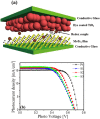Large area growth of MoTe2 films as high performance counter electrodes for dye-sensitized solar cells
- PMID: 29311582
- PMCID: PMC5758823
- DOI: 10.1038/s41598-017-18067-6
Large area growth of MoTe2 films as high performance counter electrodes for dye-sensitized solar cells
Abstract
A cost effective and efficient alternative counter electrode (CE) to replace commercially existing platinum (Pt)-based CEs for dye-sensitized solar cells (DSSCs) is necessary to make DSSCs competitive. Herein, we report the large-area growth of molybdenum telluride (MoTe2) thin films by sputtering-chemical vapor deposition (CVD) on conductive glass substrates for Pt-free CEs of DSSCs. Cyclic voltammetry (CV), Tafel curve analysis, and electrochemical impedance spectroscopy (EIS) results showed that the as-synthesized MoTe2 exhibited good electrocatalytic properties and a low charge transfer resistance at the electrolyte-electrode interface. The optimized MoTe2 CE revealed a high power conversion efficiency of 7.25% under a simulated solar illumination of 100 mW cm-2 (AM 1.5), which was comparable to the 8.15% observed for a DSSC with a Pt CE. The low cost and good electrocatalytic properties of MoTe2 thin films make them as an alternative CE for DSSCs.
Conflict of interest statement
The authors declare that they have no competing interests.
Figures






References
-
- O’regan B, Grfitzeli M. A low-cost, high-efficiency solar cell based on dye-sensitized. Nature. 1991;353:737–740. doi: 10.1038/353737a0. - DOI
-
- Kay A, Grätzel M. Low cost photovoltaic modules based on dye sensitized nanocrystalline titanium dioxide and carbon powder. Solar Energy Materials and Solar Cells. 1996;44:99–117. doi: 10.1016/0927-0248(96)00063-3. - DOI
-
- Xia J, Masaki N, Jiang K, Yanagida S. The influence of doping ions on poly (3, 4-ethylenedioxythiophene) as a counter electrode of a dye-sensitized solar cell. Journal of Materials Chemistry. 2007;17:2845–2850. doi: 10.1039/b703062b. - DOI
Publication types
LinkOut - more resources
Full Text Sources
Other Literature Sources
Molecular Biology Databases

